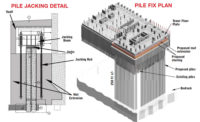ThyssenKrupp’s Ropeless Elevator on the Horizon

The system under development uses magnetic levitation, rather than ropes; allows more than one cab per shaft, much like a subway line; and reduces the footprint of the shaft.
IMAGES COURTESY OF THYSSENKRUPP

Rottweil tower, at 246 meters in height, will test and certify the ropeless elevator system starting in 2017, after completion of tower constuction next year. Rope lifts also will be tested.
IMAGES COURTESY OF THYSSENKRUPP

Tower will be the only elevator test tower to double as an observation tower.
IMAGES COURTESY OF THYSSENKRUPP



The first ropeless, tall-building elevator—a compact, lightweight system that mimics a subway line on end—is set to enter the testing and certification stage in early 2017. If all goes as planned, ThyssenKrupp Elevator AG expects to have its linear-drive system, designed to travel vertically, horizontally or on an incline, ready for the market in four years.
“Elevators have been a limiting factor in the past” in the development and design of tall buildings, said Markus Jetter, head of development for ThyssenKrupp (TK), at the Council on Tall Buildings and Urban Habitat’s 2015 conference, held from Oct. 26-28 in New York City. “This opens a completely new dimension for buildings in height and shape,” added Jetter at the CTBUH event, which drew 1,200 registrants from 45 nations.
Critical to the schedule is completion—expected at the end of next year—of what will become, for a time, the world’s tallest elevator test tower and the first to double as an observation tower. In 2017, the 246-meter tower in Rottweil, Germany, equipped with 12 elevator shafts in its 21-m-dia reinforced-concrete core, will begin testing TK’s ropeless high-rise transportation system, called Multi.
“Multi generates more handling capacity and shorter waiting times independent of travel height,” said Jetter. TK, among the world’s four biggest elevator companies, will not reveal its three-year research-and-development investment in Multi, other than to say the company spent a total of $771.4 million on R&D in the September 2013-14 fiscal year, the last year for which figures are available.
Test Towers Grow Up
The race among elevator makers for the world’s tallest test tower is heating up. The Rottweil tower may lose its title as the tallest test tower to Canny Elevator Co. Ltd., which is building a 288-m-long test facility with a 268-m tower, in Wujiang China. KONE Inc. expects to complete a test tower approximately 226 m tall in Kunshan, China, this year; it will then hold the height record until the TK or the Canny project is done. There may be taller test towers rising, but only the $44-million Rottweil tower will have an observation deck open to the public.
Multi, already prototyped, operates on the basic premise of a circular system. A single loop—or guideway—can contain several cabs.
“It’s similar to a subway, with multiple trains using the same rail and riding in the same direction on one track,” said Jetter.
In the vertical mode, each cab will cantilever from its side rail and be equipped with a linear motor drive, adapted from TK’s Transrapid magnetic-levitation train. Applied to vertical transportation, this technology maximizes shaft efficiency in mid- to high-rise buildings because each shaft accommodates more than one cab, says TK. Shaft transport capacities will increase by 50%, and elevator footprints will be reduced by up to 50%, according to TK.
The system will be best suited for buildings taller than 300 m. TK is aiming for a cab speed of 5 m per second, which will enable access to an elevator cab every 15 to 30 seconds, with a transfer stop every 50 m. Though there are faster elevators, the total time to destination is shorter because of shorter waiting and loading times, said Jetter.
“There will still be sky lobbies for supertall buildings, and one Multi can serve several sky lobbies,” he added. Multi also can be used with conventional elevators. The system allows for 6-sq-m shafts—about a third smaller than others— because there are no ropes, there is a multilevel brake system, and there are inductive power transfers from the shaft to the cab. Cabs will weigh 50% less than traditional cabs, thanks to lightweight composite construction.
Multi will have a higher first cost than rope systems but will free up floor space. The smaller shaft space also would give the developer the option to reduce the overall footprint of the building, which would mean lower first costs of other systems, said Jetter.
Safety
Propulsion and braking systems in the cabs, combined with a control system that prevents cabs from getting too close to each other, ensure safety, says TK.
A newly developed linear drive—a magnet—enables a single motor to perform horizontal and vertical movements. An exchanger turns the cab’s drive to move the cab horizontally—on a turned guiding system, from one vertical shaft to another—keeping the cab itself vertical at all times, said Jetter.
Three of the shafts in the Rottweil tower are reserved for Multi testing and certification. In the other shafts, TK will test systems with travel speeds of up to 64.8 kilometer per hour.
Ed. Züblin AG began work on the 10,000-sq-m tower, which includes a slipformed core, last March. Designed by architect Helmut Jahn and architect-structural engineer Werner Sobek, the tower will be wrapped in 17,000 sq m of a lightweight polytetrafluoroethylene-coated fiberglass fabric.
The observation level is 232 m above grade. Access will be up a dedicated glass-enclosed elevator on the outside surface.
All heat generated by devices such as motors and computers is stored in an air cell above a half-height shaft. Heat exchangers will transmit heat to the tower’s rooms, including a conference center. Traction elevators will generate electricity when in use.
A tuned mass damper, meant to reduce cross-wind-induced vibrations from a sway of +/- 800 millimeters to +/- 150 mm, will have an effective mass of 240 tonnes and is adjustable for a range of 0.165 to 0.21 Hz, said Christian
Meinhardt, a director with GERB Schwingungsisolierrungen GmbH & Co. GERB designed the single pendulum, steel-framed TMD, with prefabricated concrete slabs for the counteracting mass. Installation is set for next month.
The TMD’s mass is attached to linear drives, similar to those of Multi, said Meinhardt. The drives will excite artificial vibrations in the tower to test the lifts under sway conditions, he added.
The tower will rank as Germany’s second tallest, after the 368-m Berlin TV Tower. But the Rottweil tower’s observation deck, at 232 m, will allow the public to rise 29 m higher than the Berlin tower’s 203-m-high deck.










